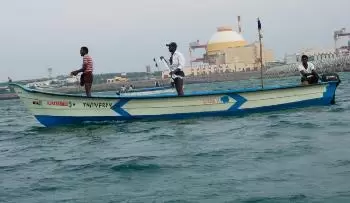'Experts overlooked the welds in Kudankulam reactor'

23-June-2012
Vol 3 | Issue 25
Prime Minister Manmohan Singh disclosed on his return from Moscow last December that the long delayed Koodankulam Nuclear Power Project would be commissioned in about a fortnight’s time.
Ever since, V Narayanasamy, minister in the PMO, has been repeating ad nauseam the project would go critical in the “next fortnight.”
 |
|
Over 30 “experts” inspected the Koodankulam plant in last few weeks, but none noticed the beltline welds in the reactor (Photo: Antony Kebiston Fernando)
|
More than a dozen fortnights have come and gone but there is no sign of loading enriched uranium fuel rods into the third generation pressurised water reactor supplied by Russia. It is said to have incorporated all the latest safety features available in the East and the West.
However, the reactor pressure vessel supplied by Russia was found to be an obsolete model developed during the early 1980s.
According to the original design approved by the Atomic Energy Regulatory Board (AERB) and contracted by the Nuclear Power Corporation of India Limited, the pressure vessel did not contemplate welds in the core region.
The vessel supplied by Russia has two welds in the core region. It is clearly a breach of contract by Russia. NPCIL officers are guilty of installing unsafe equipment with high risk of pressure vessel failure leading to offsite radiological contamination, besides causing financial loss in case of premature retirement of the reactor.
AERB has abdicated its responsibility by clearing the unsafe pressure vessel to be installed.
During the last few weeks, more than 30 “experts,” including former President APJ Abdul Kalam, have inspected the Koodankulam plant and certified the reactor was the safest in the world. None of them noticed the beltline welds in the pressure vessel.
There are hundreds of other parameters relevant for the safety and longevity of the reactor. But the NPCIL refuses to divulge the safety analysis report of the Koodankulam project in Parliament or to the public on the plea the Russian government owns the report and that it was holding it in a fiduciary capacity.
Experts say pressure vessel is the heart and soul of the reactor. While generating heat, it also produces radioactive wastes that need to be contained for thousands of years.
The vessel houses the fuel assembly of 100 tons uranium fuel of four per cent enrichment and 391 tons of water. Temperature of water during normal operation ranges from 291c to 321c.
Fission of one U235 atom generates two atoms of fission products and about three neutrons and various types of deadly radiations.
While most of the fission products are confined in the fuel assembly, neutrons and gama rays fly away from the fuel matrix and hit the wall of the pressure vessel which is subject to ageing due to radiations and heat, resulting in considerable changes of the materials structure and properties.
The development of these nano-scale defects can result in hardening, a process known as irradiation-embrittlement. The neutron flux and embrittlement rate is highest at the core beltline of the pressure vessel.
Within the first five operational years about 50 per cent of the total embrittlement will occur. According to the International Atomic Energy Agency, “nuclear steam system vendors are designing the reactor pressure vessels such that the beltline region does not contain any welds. This is accomplished by using very large ring forgings to fabricate the shell course.”
The reactor pressure vessel’s design life is 40 years. AERB says “the effect of lifetime neutron influence on these welds was evaluated and found to be acceptable.”
However, experts say: “Reactor pressure vessel failure could result in an early failure of the containment. A brittle pressure vessel failure could not only induce core meltdown but also destroy supporting structures and the containment by pressure vessel missiles.
“The safety systems like emergency cooling circuit systems are not designed to compensate brittle fracture caused by catastrophic failure of the pressure vessel. International state-of-the-art practice requires proof of sufficient safety margins before start of operation.”
Once the reactor is commissioned, it will be next to impossible to do any detailed study of the pressure vessel because of high radiation fields.
A recent study from Max Planck Institute for Chemistry and the Institute for Advanced Sustainability Studies, Potsdam, Germany, says, “High human exposure risks occur around reactors in densely populated regions, notably in West Europe and South Asia, where major reactor accident can subject around 150,000 sq km of land to radioactive contamination.”
If the Russian reactors are the best and the safest in the world, as claimed by them, why are they refusing to offer any liability in case of an accident?
Defying even the watered down Indian nuclear liability law, the Russians insist that the Inter-Governmental Agreement signed in secrecy by the Indian and the Russian governments in 2008 preceded the liability law and that Article 13 of the agreement clearly establishes that the NPCIL is solely responsible for all claims of damage.
The people of Tamil Nadu and Kerala are deeply concerned about their safety and wellbeing as the Koodankulam nuclear power plant pose grave threats.
Even the Sri Lankans, across the Pak Bay, are worried. Bracing itself for any possible disaster at the Koodankulam plant, the Sri Lankan Atomic Energy Authority is setting up eight early warning detectors along its coastal belt.
“The Koodankulam plant is the closest to us with just 200 km away,” said RL Wijewardene, chairman of the island nation’s Atomic Energy Authority.
The actual sitting of the reactors, the quality of construction and pipe work and the overall integrity of the structures have been called into question by the very workers and contractors of the project.
The expert team of People’s Movement Against Nuclear Energy (PMANE) has identified several serious safety issues with regard to geology, hydrology, oceanography and seismology such as karst, geysers and sub-volcanic intrusion in the locality, slumps in the sea and possible tsunamis, and recurrent earthquakes in the Indian Ocean.
Demanding immediate halt of the project, SP Udayakumar, convener of the People’s Movement Against Nuclear Energy, has called for a thorough scrutiny of the Environmental Impact Assessment, Safety Analysis Report and Site Evaluation Report.
He said the project had been imposed on an uninformed and unwilling people throwing all democratic precepts and values to the wind. The Koodankulam and the NPCIL officials have not conducted any mock drills and evacuation drills in the 30 km or even the 16 km radius of the project.
On 9 June, the Tirunelveli district administration and NPCIL officials conducted a sham safety drill in a remote hamlet called Nakkaneri of hardly 300 people and claimed the mock drill was a great success. More than 1.5 million people live within 30 km radius of the Koodankulam plant, which far exceeds AERB stipulations.
According to AERB instructions of 1998, the Koodankulam project requires two sources of fresh water from the Pechiparai and the Upper Kodayar in Kanyakumari district.
Since water from Pechiparai and Kodayar has been ruled out following an agitation by farmers in Kanyakumari district, four giant desalination plants, each with a capacity to produce 106,000litres of water an hour, have been set up near the nuclear power plant.
The desalination plants are vulnerable to accidents and terrorist attacks and cannot be a reliable source of fresh water.
If this is the level of efficiency, accountability, trustworthiness and responsiveness of the Department of Atomic Energy to the Koodankulam project, it is no wonder that the people, particularly those living in the vicinity and directly affected by this unwanted project, have no faith in the abilities of the scientific, technical and managerial staff supposed to rescue them in the event of a Fukushima-type disaster.
The people have been peacefully agitating and observing fasts against this dangerous project as taught by the father of the nation, Mahatma Gandhi.
But the UPA government, by putting down the protests ruthlessly with brute police force, has demonstrated that it is no respecter of Gandhian ideology or practice.
Sam Rajappa is Consulting Editor of The Weekend Leader
















